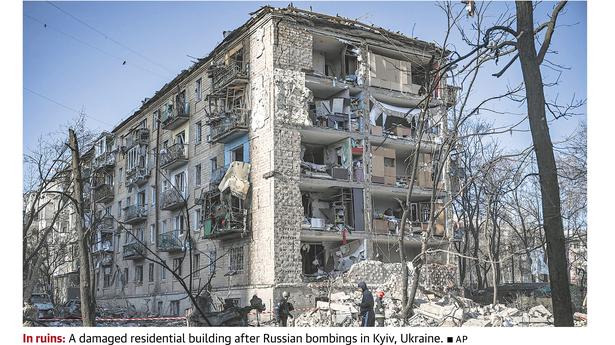
Kyiv | The epicentre of Ukrainian resistance
The Hindu
The Russian bid to envelope the capital city appears to be stalled, even though the invading troops have made advances in the east and south
Twenty-three days have passed since the Russian invasion of Ukraine began. A look at the map of operations under way in the invasion would quickly suggest that the invading forces are trying to encircle the capital city of Kyiv from the northwest, west and the east of the country.
This, along with the bombing operations Russian troops are carrying out elsewhere in the country, would appear to be in line with their stated aim of “demilitarising” Ukraine. Some also argue that Russians would want to create a regime that would be favourable to the Russian axis — a conjuncture that has not been available to Moscow since former President Viktor Yanukovych fled the country and exiled to Russia following widespread protests against his regime in 2014.
One of Eastern Europe’s oldest cities, Kyiv gained prominence as the capital city of the Kievan Rus, the first Eastern Slavic state in 9th century AD, but after being destroyed during the Mongol invasions, it lost its importance becoming a provincial capital of territories that were under the control of Lithuania, later Poland and Russia in the 17th century. Under Russian thrall and later industrial revolution in the 19th century, the city became first a trade centre and by 1900, a significant industrial centre. Kyiv was later the capital of Soviet Ukraine and a centre of major industrialisation. After the collapse of the Soviet Union, the city steadily remodelled and evolved itself as a centre to high-tech industries and higher education centres, contributing significantly to Ukraine’s overall GDP.
Kyiv is not only Ukraine’s capital city, but is among the regions in the country with the highest net support for Ukraine joining the European Union as opposed to an alliance with Russia. For example, during the Euromaidan protests in November 2013 against Yanukovych’s regime, which had chosen suddenly not to sign the European Union-Ukraine Association Agreement that had been voted for, overwhelmingly, by Ukraine’s Parliament, polls showed that the highest support for the protests were in Kyiv (75%) as opposed to a near 50-50 split for and against the protests in the country overall.
Since 2014, the Russian annexation of Crimea, the escalating conflict and later stalemate in Donbas, and other economic pressures only indicated Russia’s attempts at restoring control over Ukraine and weaning away from the EU/NATO axis. These had, even before the invasion, only made Kyiv harden its line on agreeing to political concessions to Russia and prevented a lasting peace between the neighbours. Some experts had cautioned that Russia would indeed utilise the means of an invasion to achieve its strategic aims in Ukraine and to seek effective control over Kyiv and that has indeed to come to pass.
However, as things stand, reports from the country have shown that the Russian invasion has been stalled on the Kyiv front and the northwest, even though Moscow says its “special military operation” is going ahead as per plan. The Washington DC-based Institute of Study of War, in its March 18 update, said “Russia did not conduct any offensive operations northwest or northeast of Kyiv” and that its efforts to “encircle or seize Kyiv remain stalemated as of March 18”.
Clearly fierce counter-attacks from the Ukrainians have lent a heavy toll on the Russian forces, especially behind Russian lines. Ukraine has also managed a campaign on the psy-ops front to portray that the Russian morale is flagging and that the invading forces are now increasingly using repression in the areas under its control, even as it has so far failed to capture major cities, except Kherson in the south.

U.S. President Donald Trump threatens 200% tariff on wine, champagne from France, other EU countries
Trump threatens 200% tariffs on European alcohol in response to EU levies, sparking trade tensions and market uncertainty.












